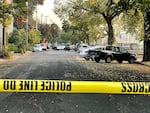Portland breezed past last year’s record 92 homicides and planted a new flag on Nov. 23 when the city recorded its 93rd homicide of the year. The victim, 45-year-old Raja McCallister, was shot and killed last Wednesday in the Creston-Kenilworth neighborhood, police said in a statement.

Police tape blocks off North Commercial Street near Jefferson High School after shots were fired on Tuesday, Oct. 18, 2022.
Jonathan Levinson / OPB
The 93 deaths include four people who were shot by Portland police and a man killed by a Clackamas County Sheriff’s Office deputy during a pursuit into Portland.
The grim milestone comes nearly two years after Portland Mayor Ted Wheeler sparked ire among many activists when he announced plans to resurrect the disbanded Gun Violence Reduction Team’s capabilities. The controversial unit, which a city audit found disproportionately targeted people of color, was broken up in 2020 in response to racial justice protesters’ demands.
The concession didn’t last long.
Gun violence began increasing in the second half of 2019, if not earlier, and the increase accelerated through 2020 and into 2021. Faced with a rise in shootings, city hall backtracked. The gun violence team’s investigative capabilities were brought back with the launch of the Enhanced Community Safety Team in February 2021, and the violence interruption mission was relaunched a year later in January 2022 when the Focused Intervention Team, known as FIT, began its work.
“FIT officers aren’t just responding to violence,” Wheeler said at a March 17 press conference. “They are working to prevent violence from happening in the first place.”
At the press conference, Wheeler highlighted the many successes the team had in its first two months on the streets, pointing to more than 80 arrests, 25 seized firearms and over 500 calls for service.
“It shows that police reform is working,” Wheeler said. “If we had more funds for more officers and more [public safety support specialists], we could do more to bring public safety to more Portlanders using a community-led community policing model.”
Nearly a year in, and with police bureau recruitment in overdrive, that claim is being undercut by the data.
The police bureau currently has 795 sworn officers and 87 vacancies. That includes everyone with policing powers, such as detectives, the chief and assistant chiefs. Of those, 533 officers and 72 vacancies are at the lowest Community Police Officer rank, the officers who work patrol shifts, answer 911 calls and are responsible for day-to-day policing.
Although staffing levels overall are lower today than they were in February 2021 when the mayor started reintroducing the gun violence team, it is the pace of recruitment and training, not funding, dragging down the numbers.
“The Bureau is finally at the point where our hires are outpacing our retirements and resignations,” said PPB Spokesperson Lt. Nathan Sheppard. “It still takes around 18 months to fully train officers.”
Although the number of officers the bureau is allotted has been lowered by 30 since February 2021, a long-anticipated wave of retirements plus additional resignations has for years left PPB falling short of full employment regardless of what its budget permits.

A liaison officer with the Portland Police Bureau watches people at a rally organized by the Proud Boys, labeled a hate group by the Southern Poverty Law Center, in Portland, Ore., Saturday, Aug. 17, 2019.
Bradley W. Parks / OPB
And it’s a budget that has grown precipitously in recent years, despite tens of thousands of Portlanders taking to the streets for months in 2020 to demand sizable chunks of the police budget be redirected to policing alternatives.
The police bureau budget was $238 million in 2020. After dipping slightly in 2021, it rebounded to a record $249 million in the 2022-23 budget cycle.
Research on how police impact crime rates is mixed. One study in Buenos Aires found that car thefts declined in areas around the city’s Jewish institutions after police ramped up their presence in the wake of a bombing.
A recent study in the United States found that for every 15 to 20 additional officers in a department, one homicide will be prevented. Based on those numbers, it would require an additional 855 officers to bring Portland homicides back to 2019 levels. That same study also found an increase in the number of police leads to an increase in low-level arrests for things like public intoxication or drug possession. Those arrests have no impact on violent crime and, the study found, 1 in 10 or 20 will result in a different form of violence: police use of force.
Sheppard sees a role for police in addressing gun violence but said it isn’t a problem they alone can solve.
“Factors such as homelessness, drug addiction and dependency, socioeconomic factors, etc. are issues that could affect the violence we’re seeing, but aren’t something that law enforcement can solve. It’s going to require a whole of community approach,” he wrote in an email to OPB.
Crime rate fluctuations aren’t very well understood but social factors are widely thought to play a significant role. According to a city-commissioned analysis of homicides between 2019 and 2021, a large share of Portland homicides is linked to what the city calls groups or networks, essentially gangs. But according to Portland State University criminology professor Brian Renauer, that culture of violence and retaliation doesn’t develop overnight, it’s a long-term product of social erosion.
“People who have succumbed to that worldview have lost any sort of sense of hope or opportunity in legitimate societies and legitimate means and avenues,” Renauer said. “It’s the result of … a breakdown in family, a breakdown in school, a breakdown in employment economic opportunities.”
Wheeler’s attempts to curb the worsening gun violence problem have also sought to address those more entrenched, longer-term ills. In July, he declared a gun violence emergency aimed at reducing shootings by 10% over the next two years. As part of his Safer Summer PDX initiative, he introduced the Focused Investment Group, a $2.7 million program tasked with intervening to “persuade those at highest risk of shooting not to shoot,” engaging at-risk youth, and investing in communities to “address environmental factors conducive to gun violence.” The group has spent $2.57 million so far.
In a statement, Wheeler said his priorities for the next two years are addressing houselessness and crime. He said the city is investing in community-based outreach and restaffing the police bureau and added that for people who aren’t persuaded to “step away from this violence,” the criminal justice system remains an option.
“We will do everything in our power to see that gun criminals and murderers are held accountable to the fullest extent of the law in every way possible, including potentially long federal prison sentences,” Wheeler said.
Safer Summer PDX programs have included a two-day training and mentorship program for high school students at a local clothing company, career training in the beauty industry and a four-day training on music industry careers.
And in April 2021, City Council approved a $6 million plan to address gun violence. That ordinance set aside more than $4 million for grants to nonprofits working with the city’s Office of Violence Prevention.
Wheeler said at the time that money would target “youth who might be tempted to engage with affiliated groups or gangs” and go to upstream interventions like educational and after-school opportunities and community family support.
Still, shootings and homicides in Portland have continued at an unrelenting pace even as national rates have abated some.
The national homicide rate dropped by 50% between 1991 and 2014, going from 9.8 to 4.4 murders per 100,000 people. Then, in 2020, it increased by 30%. The recent turnaround undid some of the progress won during the 90s and early 2000s. The U.S. currently sits around 6.8 per 100,000, still a far cry from 1991 levels.
Nationally, the current surge might be slowing. Data by AH Datalytics, a group that closely tracks homicide rates in big cities across the U.S., suggests homicide rates are down in 2022 by as much as 4%.
And while the spike showed no regard for population density, geography or politics, it continues to be especially pronounced in Portland.
The city is on pace for about 15.6 murders per 100,000 people. That would put Portland a few steps up from where it ranked in 2021, somewhere between Nashville and Dallas.
